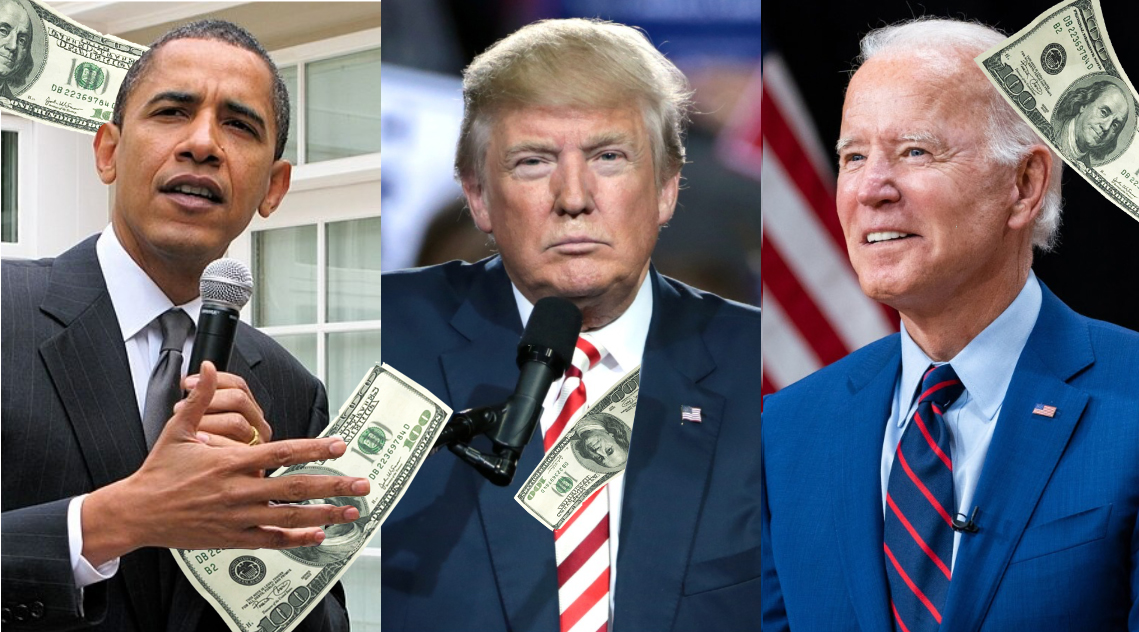The Trump administration focused federal transportation grants on widening rural highways while the Biden administration prioritized multimodal projects in communities of color, according to a new analysis of one of America's most critical discretionary grant programs.
In a new report, researchers at the Urban Institute analyzed how equitably the last three administrations have distributed funds from the Rebuilding American Infrastructure with Sustainability and Equity program (aka RAISE grants), which is not only one of the U.S. DOT's largest programs, but also one of its most flexible.
Though "equity" is right there in the name today — and statutory requirements require the funds to be equitably distributed among the states, as well as between urban and rural areas — the core values driving RAISE program decisions have morphed every time a new DOT has taken the helm, along with the very name of the program itself.
RAISE Program Grants include investments that will:
— Federal Highway Admn (@USDOTFHWA) August 24, 2022
🌳Fight climate change and reduce emissions
🚍Increase transportation options
🚲Increase safety
🛣️Modernize and update roads, bridges, rail, highways
👪Reduce costs for American familieshttps://t.co/x4cQYCutDB #RAISEGrants pic.twitter.com/1Q7nKtjMvI
Big news for America’s infrastructure! @USDOT is announcing $1 billion in BUILD grants that will repair, rebuild, and revitalize transportation systems across America! https://t.co/PSTSgAYqgl
— Sec. Elaine Chao (@SecElaineChao) September 16, 2020
Under President Barack Obama, for instance, RAISE was known as Transportation Investment Generating Economic Recovery (TIGER), and it focused predominantly on projects meant to revive the hardest-hit local communities in the wake of the 2009 financial crash.
Under Trump, though, the program was renamed Better Utilizing Investments to Leverage Development (BUILD), and it focused heavily on projects that the administration believed would catalyze new growth.
No matter what it's called, though, such grants can radically and directly reshape local communities without state DOTs getting involved — and can give a glimpse into a federal administration's larger vision for America's transportation future.
"This research counteracts the narrative that whoever's in office doesn't have an impact on your backyard or your street," said Gabe Samuels, who co-authored the report. "Because we see, quite literally, that they do — that over time, the administration really has an impact on these local investments."
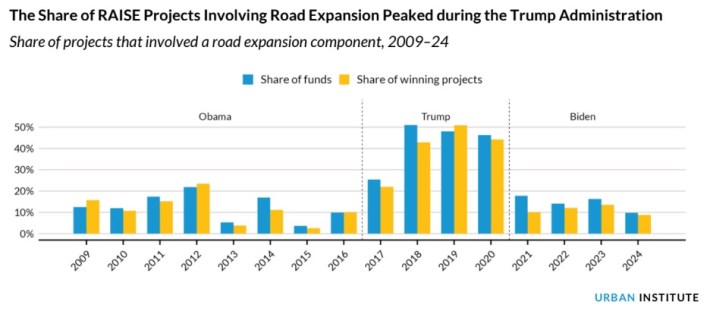
Samuels and co-author Amanda Hermans found that the sheer malleability of the RAISE program generated wildly different outcomes depending on who was in charge (and who that person appointed to head the DOT).
Under Obama, for instance, about 40 percent of winning applications included some element related to transit, compared to 30 percent during Biden's term and just 15 percent during Trump's.
Under the latter, up to half of funds in any given year went to projects that "expanded or built new highways," which experts say can increase car travel and all the emissions, crashes, and social consequences that come with it. Under the current president, by contrast, up to half of funds went to projects that served multiple non-automotive modes.
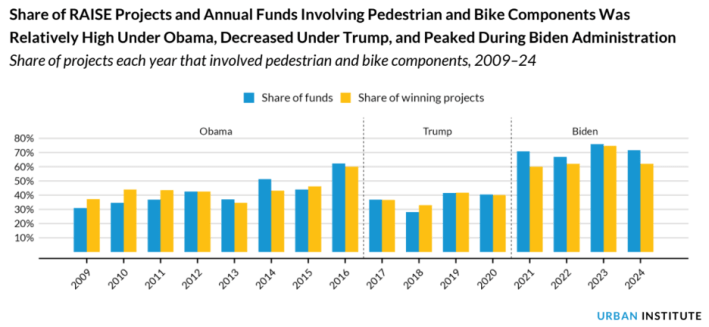
Of course, neither Trump nor Biden's Vice President and current candidate Kamala Harris will necessarily repeat that history, and their cabinet heads might not, either. (Trump's former Secretary of Transportation Elaine Chao resigned over Trump's response to the January 6th riots, and Biden's current Secretary, Pete Buttigieg, has been coy about his own future in any potential Harris administration.)
Still, the research shows that the next administration could have a visible impact on how RAISE decisions are made — and that voters who care about transportation should bear it in mind.
"We don't know that whoever is in office next will follow the patterns of previous administrations, whether it's a second Trump administration, or the vice president of the current administration," stressed Hermans. "But it could give some indication as to what could happen in coming years — or at least, it could give the indication that [how RAISE grants are awarded] will change with any administration change."
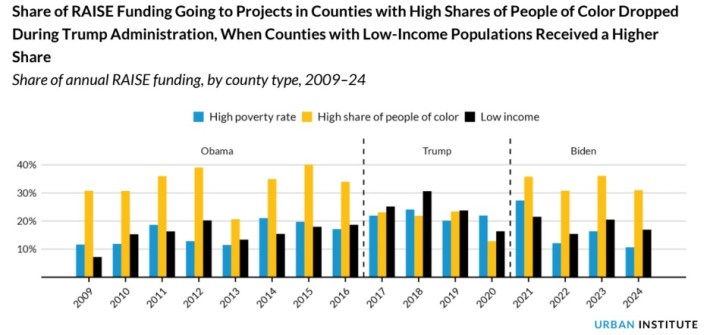
When it comes to who gets a RAISE from federal transportation officials, the researchers noticed stark differences, too — especially since the program doesn't require grant administrators to consider race or income when they distribute funds.
For instance, both Democratic administrations awarded 33 percent of funding to projects in counties with a high share of people of color, but the lone Republican president awarded just 20 percent. However, the Democrats were both less likely than Trump to fund projects in counties with lower average household incomes, which the researchers chalked up to the fact that his administration "was more likely to prioritize projects in rural areas."
The report authors noted, though, that while "the Trump administration sent more funding to lower-income counties, it funded projects in higher income neighborhoods within those counties."
At the neighborhood level, by contrast, both Democrats were "far more likely" to fund projects in areas with lower incomes, even if the counties that surrounded them were relatively rich — a finding which the researchers say indicates that at least in this program, Biden's Justice 40 initiative is working.
"Looking at the clear prioritization of disadvantaged communities since 2021, the Biden DOT has walked the walk," added Samuels.
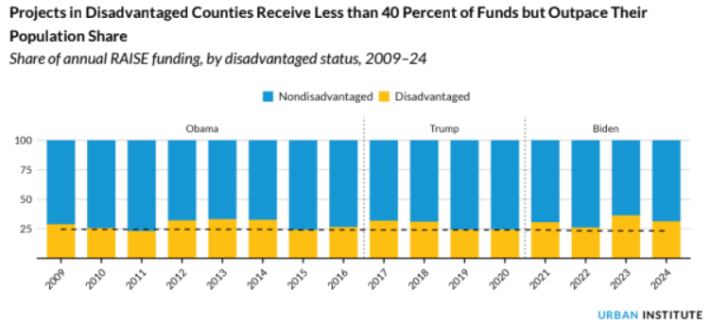
Of course, none of the three presidents has gotten a perfect score on equity.
The researchers found that at the county scale, disadvantaged communities "consistent receive less than 40 percent of RAISE funds in a given year," even if they do better at the neighborhood scale, and tend to win more funding per resident than their advantaged counterparts.
Many of the disadvantaged counties in America, meanwhile, don't even apply for the funds at all, which "suggests that there remain systemic challenges to applying for RAISE grants that could be addressed by additional federal support and potentially state-level assistance to communities." (Some non-profit groups, like Bloomberg Philanthropes' Local Infrastructure Hub, are trying to fill those gaps in the meantime.)
Moreover, stats on allocation alone can't paint a full picture of how this program impacts vulnerable communities, since road expansion "investments" might increase air pollution in surrounding neighborhoods, and even biking, walking, transit dollars can be deployed in inequitable ways that leave current residents out of the conversation.
Still, the report authors say that the RAISE program can live up to its name of helping more disadvantaged communities ascend to better equity outcomes — starting with expanding application support to places that struggle to even apply. DOT might even incorporate "impact analyses" that quantify things like emissions, residential displacement, and increases (or decreases) in accessibility associated with a proposed project, and only award money to the efforts that give the most vulnerable the best bang for their buck.
Whether that happens, though, will depend at least in part in who wins the White House in November.
"We can't say that one candidate will do a better job anything like that," added Samuels. "But the candidate does matter, [and there's a] clear correlation between who is in office and how administrative priorities change under [their influence]."
